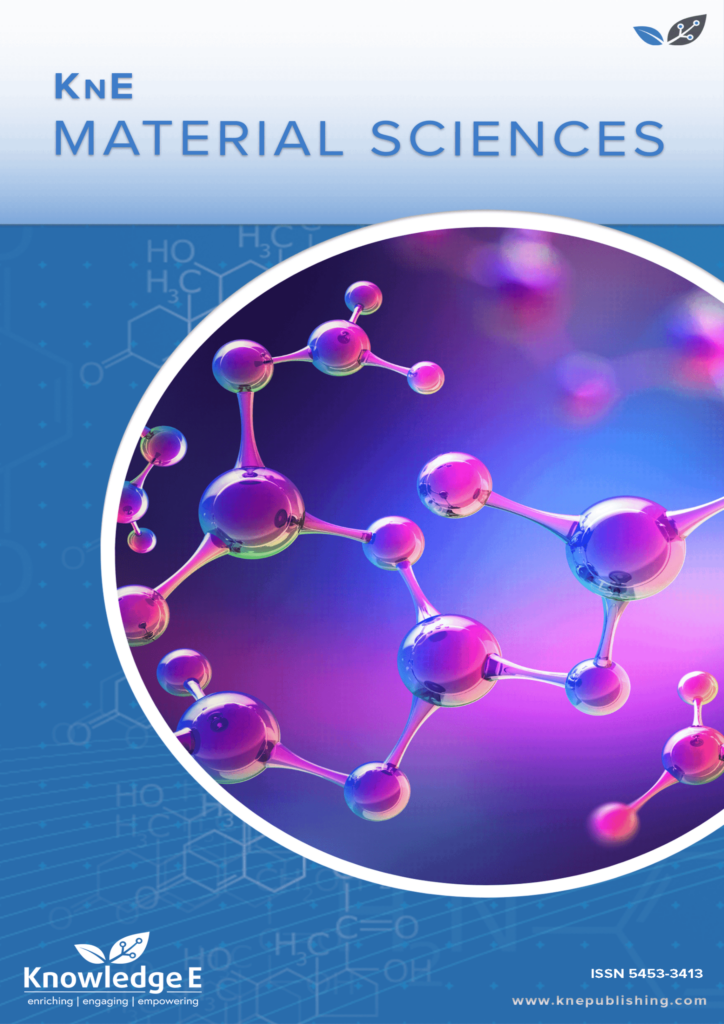
KnE Material Sciences
ISSN: 2519-1438
The latest conference proceedings on physical materials, energy materials, electrical materials.
Dielectric Permittivity Enhancement By Charged Domain Walls Formation In Stoichiometric Lithium Niobate
Published date:Oct 12 2016
Journal Title: KnE Material Sciences
Issue title: IV Sino-Russian ASRTU Symposium on Advanced Materials and Processing Technology (ASRTU)
Pages:57-63
Authors:
Abstract:
We present an experimental study of contribution of charged domain walls into dielectric permittivity of lithium niobate. It has been shown that formation of dense structure with spike-like domains leads to order of magnitude increase of permittivity, which gradually decreases with time. The decrease rate accelerates under DC bias. Dielectric permittivity decreases linearly with a logarithm of frequency. The obtained results were explained considering vibration of the steps on the charged domain walls.
References:
[1] A. Crassous, T. Sluka, A. K. Tagantsev, and N. Setter, Polarization charge as a reconfigurable quasidopant in ferroelectric thin films, Nature Nanotechnology, 10, no. 7, 614–618, (2015).
[2] R. Xu, J. Karthik, A. R. Damodaran, and L. W. Martin, Stationary domain wall contribution to enhanced ferroelectric susceptibility, Nature Communications, 5, article no. 3120, (2014).
[3] T. Sluka, A. K. Tagantsev, D. Damjanovic, M. Gureev, and N. Setter, Enhanced electromechanical response of ferroelectrics due to charged domain walls, Nature Communications, 3, article no. 1751, (2012).
[4] T. Nattermann, Y. Shapir, and I. Vilfan, Interface pinning and dynamics in random systems, Physical Review B, 42, no. 13, 8577–8586, (1990).
[5] D. V. Taylor and D. Damjanovic, Domain wall pinning contribution to the nonlinear dielectric permittivity in Pb(Zr,Ti)O3 thin films, Applied Physics Letters, 73, no. 14, 2045–2047, (1998).
[6] D. V. Taylor and D. Damjanovic, Evidence of domain wall contribution to the dielectric permittivity in PZT thin films at sub-switching fields, Journal of Applied Physics, 82, no. 4, 1973–1975, (1997).
[7] A. E. Glazounov and A. K. Tagantsev, A ”breathing” model for the polarization response of relaxor ferroelectrics, 57–66
[8] V. Y. Shur, E. L. Rumyantsev, E. V. Nikolaeva, and E. I. Shishkin, Formation and evolution of charged domain walls in congruent lithium niobate, Applied Physics Letters, 77, no. 22, 3636–3638, (2000).
[9] V. Y. Shur, A. R. Akhmatkhanov, and I. S. Baturin, Fatigue effect in stoichiometric LiTaO 3 crystals produced by vapor transport equilibration, Ferroelectrics, 426, no. 1, 142–151, (2012).
[10] M. Schröder, X. Chen, A. Haußmann, A. Thiessen, J. Poppe, D. A. Bonnell, and L. M. Eng, Nanoscale and macroscopic electrical ac transport along conductive domain walls in lithium niobate single crystals, Materials Research Express, 1, no. 3, Article ID 035012, (2014).
[11] V. Y. Shur, I. S. Baturin, A. R. Akhmatkhanov, D. S. Chezganov, and A. A. Esin, Time-dependent conduction current in lithium niobate crystals with charged domain walls, Applied Physics Letters, 103, no. 10, Article ID 102905, (2013).
[12] A. A. Esin, A. R. Akhmatkhanov, I. S. Baturin, and V. Y. Shur, Increase and relaxation of abnormal conduction current in lithium niobate crystals with charged domain walls, Ferroelectrics, 476, no. 1, 94–104, (2015).
[13] K. Mizuuchi, A. Morikawa, T. Sugita, and K. Yamamoto, Electric-field poling in Mg-doped LiNbO3, Journal of Applied Physics, 96, no. 11, 6585–6590, (2004).
[14] C. Borderon, R. Renoud, M. Ragheb, and H. W. Gundel, Dielectric long time relaxation of domains walls in PbZrTiO3 thin films, Applied Physics Letters, 104, no. 7, Article ID 072902, (2014).